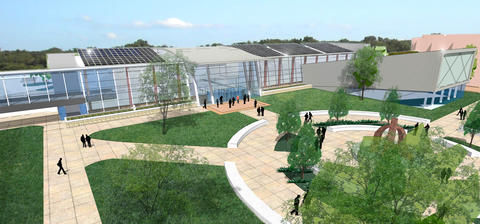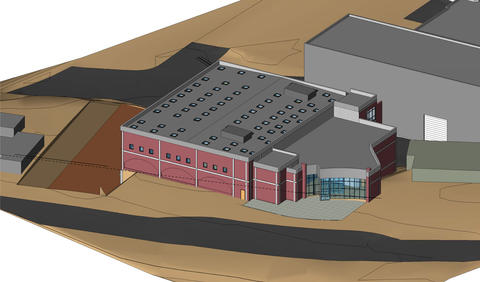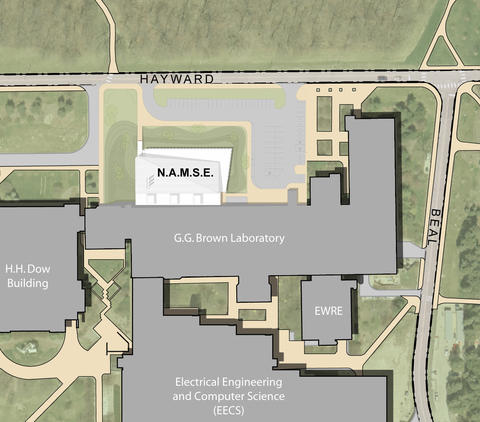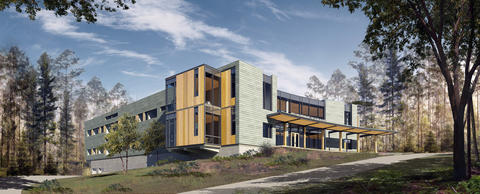Commerce Department's National Institute of Standards and Technology Awards $50 Million in Grants for the Construction of Five Science Facilities
Research Institutions in California, Maine, Michigan, Nevada and New York to Receive Funding
WASHINGTON, D.C.–The U.S. Commerce Department's National Institute of Standards and Technology (NIST) today awarded a total of $50 million in grants to five institutions to support the construction of new scientific research facilities that will explore everything from nanometer-scale electronics and "green" buildings to microbe ecosystems in the oceans. The five projects receiving funding under the NIST Construction Grant Program (NCGP) will contribute to almost $133 million in new laboratory construction projects, according to grantees.
"Strengthening research and development in the United States is critical to our ability to create jobs and remain competitive," U.S. Commerce Secretary Gary Locke said. "These construction grants will help the U.S. produce world-leading research in science and technology that will advance our economic growth and international competitiveness." The five grants announced today under the Construction Grant Program include:
- $13.1 million for the Golisano Institute for Sustainability Research Building at the Rochester Institute of Technology in New York—A new environmentally friendly building at the Institute will support green-building research and other sustainable technologies.
- $12.2 million for the expansion of facilities at the Center for Civil Engineering Earthquake Research at the University of Nevada, Reno—The laboratory expansion will result in the largest and most versatile earthquake simulation facility in the United States.
- $9.5 million for the Center of Excellence in Nano Mechanical Science & Engineering (NAMSE) at the University of Michigan, Ann Arbor—The new research facility will explore a broad range of topics at the intersection of mechanical engineering and nanometer-scale science and technology.
- $9.1 million for a new Center for Ocean Health at Bigelow Laboratory for Ocean Sciences in West Boothbay Harbor, Maine—The new research center on the coast will facilitate the study of microbial life in marine ecosystems and the health of the oceans.
- $6 million for the Western Institute of Nanotechnology on Green Engineering and Metrology (WIN GEM) at the University of California, Los Angeles—The new facility will consolidate core research facilities for three research centers developing advanced energy technologies for microelectronics and nanotechnology.
These NIST grants fund new or expanded facilities for scientific research in areas of study covered by NIST and Commerce's National Oceanic and Atmospheric Administration, including measurement science, nanotechnology, building technology and oceanography. Sponsoring organizations must be institutions of higher education or nonprofit science research organizations.
The competition for these awards was announced in February, and NIST received more than 100 proposals. Applications were evaluated based on three criteria: scientific and technical merit of the proposed use of the facility and the need for federal funding; quality of the design of the facility; and adequacy of the project management plan for construction of the facility. Applicant organizations must fund at least 20 percent of the annual project costs.
For more on the NIST Construction Grant Program, visit: https://www.nist.gov/director/recovery-act-nist-construction-grant-program. For additional information, contact Michael Baum, baum [at] nist.gov (baum[at]nist[dot]gov), 301-975-2763.
Additional Details on Projects
Golisano Institute for Sustainability Research Building
Rochester Institute of Technology
Rochester, NY
NIST Construction Grant: approximately $13,110,000
Non-Federal Cost Share: approximately $21,851,000
Total budget: approximately $34,961,000

The Golisano Institute for Sustainability (GIS) at Rochester Institute of Technology (RIT) is a unique, multidisciplinary, university research and education initiative that focuses broadly on developing and introducing sustainable technologies for manufacturing, transportation, energy production and construction. GIS offers the world's first Ph.D. program in sustainability, focusing on sustainable production systems. The planned GIS Research Building will provide a consolidated research facility for the multifaceted GIS program, pulling together researchers currently housed across six colleges on campus.
The GIS Research Building will be a living laboratory for scientific discovery and experiential learning consisting of seven systems integration test beds, eight sustainability technology support laboratories along with computing and collaborative spaces to support research programs in eco-IT (encompassing topics such as the energy efficient design of major computing facilities and sustainable materials and systems for printing and imaging), sustainable products and production systems, sustainable energy, sustainable mobility (supporting research on future transportation systems based on fuel cells, biofuels and electric vehicles) and build system sustainability (Net Zero energy buildings, sustainable building materials, sustainable architecture, smart buildings).
In designing and constructing the 75,000 square-foot (6,968 square meter) Research Building, RIT is targeting LEED platinum certification, the highest level awarded by the U.S. Green Building Council. The building itself will be a demonstration of sustainable technology. It will incorporate a unique "transparent infrastructure," a "smart" microgrid, and a computing data center so that visitors can see firsthand the use of sustainable building technologies and energy systems.
The project is expected to be completed by Fall 2012.
Contact:
Dr. Nabil Nasr
Director, Golisano Institute for Sustainability
585-475-5106
nasr [at] rit.edu (nasr[at]rit[dot]edu)
Expansion of the Center for Civil Engineering Earthquake Research Facilities at the University of Nevada, Reno
University of Nevada, Reno
Reno, NV
NIST Construction Grant: approximately $12,222,000
Non-Federal Cost Share: approximately $3,092,000
Total budget: approximately $15,314,000

The planned laboratory expansion at the Center for Civil Engineering Earthquake Research of the University of Nevada, Reno will house the largest and most versatile earthquake simulation facility in the United States.
Research on earthquakes—and how to build structures that will stand up to them—is vital for public safety and security, but extremely difficult. The forces and effects involved occur on huge scales, and large earthquakes are rare enough that researchers can't wait for one to test theories of construction. Shake tables are one answer. They are generally large support structures operated by hydraulics and capable of supporting tens of tons of mass while moving in various directions that simulate the motion of the ground during an earthquake. In the 14-university Network for Earthquake Engineering Simulation (NEES) established by the National Science Foundation, there are only three sites with shake tables, including the University of Nevada, Reno. The UNR center has made significant contributions to the U.S. National Earthquake Hazard Reduction Program (NEHRP), a multiagency task force led by the National Institute of Standards and Technology (NIST).
The new 22,650-square-foot (2,104 square meter) Shake Table Laboratory at UNR will be a state-of-the-art earthquake simulation laboratory able to accommodate up to five large-capacity shake tables (the university currently has four.) The greatly expanded research space will allow for experiment configurations that are not now possible in the existing facility, including large-scale models of buildings and experiments that simulate the effect of seismic waves propagating through layers of soil under foundations.
The project is expected to be complete by Fall 2013.
Contact:
Mike Wolterbeek
Media Relations Officer
775-784-4547
awolterbeek [at] unr.edu (awolterbeek[at]unr[dot]edu)
Center of Excellence in Nano Mechanical Science & Engineering (NAMSE)
University of Michigan
Ann Arbor, MI
NIST Construction Grant: approximately $9,477,000
Non-Federal Cost Share: approximately $31,729,000
Total budget: approximately $41,206,000

The planned Center of Excellence in Nano Mechanical Science & Engineering (NAMSE) will be a state-of-the-art research facility dedicated to a wide spectrum of research activities where mechanical engineering intersects with the growing discipline of nanoscience and technology. These include nanoscale metrology, dynamics of DNA molecules, nanoscale energy conversion, nanomanufacturing and nano/micro electromechanical systems (NEMS/MEMS) for medical research and diagnostics.
The three-story building, including one level below grade to house special ultra-low vibration (ULV) laboratories, will include 60 laboratory modules together with faculty and graduate student offices, a total of nearly 63,000 gross square feet (5,853 square meters). The special ULV facility will include eight specialized laboratory chambers designed to meet National Institute of Standards and Technology (NIST) specifications for low vibration laboratories with temperature and humidity control as well as low-particulate, filtered air.
In addition to the ULV labs, the facility will have laboratories dedicated to imaging and optics; biosystems; nanoengineering; micro-bioengineering; materials, mechanics and mechanical testing; microdynamics and nanostructures. Planned research projects for the new facility range from the analysis of single biomolecules to metrology of nanoparticle-based composites to precision nanomanufacturing and assembly.
The project is expected to be complete by Summer 2013.
Contact:
Byron Roberts
Senior Director, Communications
734-647-7034
byronr [at] umich.edu (byronr[at]umich[dot]edu)
Center for Ocean Health
Bigelow Laboratory for Ocean Sciences
West Boothbay Harbor, ME
NIST Construction Grant: approximately $9,146,000
Non-Federal Cost Share: approximately $2,288,000
Total budget: approximately $11,434,000

The Bigelow Laboratory for Ocean Sciences, a private, nonprofit research institution, focuses on understanding ocean ecosystems and their relationship to life on earth. The laboratory is a globally recognized leader in ocean research. Marine ecosystems are built upon microscopic plants and animals, and play a major role in the health of the oceans. The planned Center for Ocean Health (COH) will house the core of Bigelow's focus on the role of microbial communities in ocean ecosystems' function and resilience.
The COH will be one of three complementary and interlocking research centers on the new Bigelow Ocean Sciences Campus, along with the planned Center for Ocean Biogeochemistry and Climate Change, and the Bigelow Center for Blue Technology, which studies single-cell genomics-marine viruses, bacteria and phytoplankton. The COH will replace aging research facilities currently scattered over several dilapidated laboratories, modular structures and a truck garage.
An 18,200 gross-square-foot (1,691 square meters) main building will provide ecology, physiology, molecular biology and virology laboratories as well as facilities for "mesocosms" (experimental water tanks designed to provide near-natural conditions in a controlled environment) and large-volume algae growth, and computing resources for ecosystem modeling and bioinformatics. A nearby 1,000 gross-square-foot (93 square meter) "shore facility" will add critically needed research vessel pier and dock space, SCUBA operations support and seawater pumping facilities to support the main lab and field research.
The COH building is expected to be complete by Summer 2012.
Contact:
Dr. Graham Shimmield
Executive Director
207-633-9600 and 207-504-6430 (cell)
gshimmield [at] bigelow.org (gshimmield[at]bigelow[dot]org)
Western Institute of Nanotechnology on Green Engineering and Metrology (WIN GEM)
University of California, Los Angeles
Los Angeles, CA
NIST Construction Grant: approximately $6,045,000
Non-Federal Cost Share: approximately $23,955,000
Total budget: $30,000,000

The planned state-of-the-art building for the Western Institute of Nanotechnology on Green Engineering and Metrology (WIN-GEM) at the UCLA Henry Samueli School of Engineering and Applied Science (HSSEAS) will provide core research facilities to serve the school's "Centers of Excellence" dedicated to advanced energy conservation technologies for microelectronics and nanotechnology. The WIN-GEM building will support research on low-power, nonvolatile nanoelectronics, green manufacturing of novel nanomaterial-based energy technologies, and new materials for energy generation, storage and management.
WIN-GEM will house the Western Institute of Nanoelectronics, a Center of Excellence funded by the National Institute of Standards and Technology and the semiconductor industry to explore new low-dissipation, nonvolatile electronics; the Functional Engineered Nano Architectonics, a Center of Excellence funded by the Department of Defense, the semiconductor and defense industries to explore low-cost, high-yield, energy-efficient nanoscale manufacturing technologies for semiconductor devices; and the Energy Frontiers Research Center, funded by the Department of Energy and focusing on creating inexpensive nanoscale materials for use in polymer-based solar cells, electrochemical supercapacitors for energy storage and carbon capture.
The new WIN-GEM will accommodate 35,000 square-feet (3,252 square meters) of laboratory space on four levels. It also will provide separate facilities for a quantum metrology, microscopy, electron and spintronic transport, and a wet chemistry energy/nano lab to study the structures and properties of novel nanoscale materials for energy applications such as high-efficiency organic solar cells. The roof will include a solar cell array for energy supply and power management experimentation. Further, WIN-GEM will allow UCLA and HSSEAS to consolidate and upgrade lab facilities and equipment that are now spread out across multiple sites.
The facility is expected to be completed by Spring 2014.
Contact:
Wileen Wong Kromhout
Director of Media Relations & Marketing
Henry Samueli School of Engineering and Applied Science
310-206-0540 (o); 310-775-1354 (c)
wwkromhout [at] support.ucla.edu (wwkromhout[at]support[dot]ucla[dot]edu)

